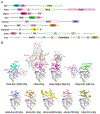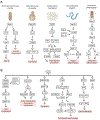Functional and structural insights into RAS effector proteins
- PMID: 39025071
- PMCID: PMC11316660
- DOI: 10.1016/j.molcel.2024.06.027
Functional and structural insights into RAS effector proteins
Erratum in
-
Functional and structural insights into RAS effector proteins.Mol Cell. 2024 Aug 22;84(16):3163-3164. doi: 10.1016/j.molcel.2024.07.024. Epub 2024 Aug 13. Mol Cell. 2024. PMID: 39142277 Free PMC article. No abstract available.
Abstract
RAS proteins are conserved guanosine triphosphate (GTP) hydrolases (GTPases) that act as molecular binary switches and play vital roles in numerous cellular processes. Upon GTP binding, RAS GTPases adopt an active conformation and interact with specific proteins termed RAS effectors that contain a conserved ubiquitin-like domain, thereby facilitating downstream signaling. Over 50 effector proteins have been identified in the human proteome, and many have been studied as potential mediators of RAS-dependent signaling pathways. Biochemical and structural analyses have provided mechanistic insights into these effectors, and studies using model organisms have complemented our understanding of their role in physiology and disease. Yet, many critical aspects regarding the dynamics and biological function of RAS-effector complexes remain to be elucidated. In this review, we discuss the mechanisms and functions of known RAS effector proteins, provide structural perspectives on RAS-effector interactions, evaluate their significance in RAS-mediated signaling, and explore their potential as therapeutic targets.
Keywords: GTPase; RAS; RAS-binding domain; RBD; effector.
Copyright © 2024 Elsevier Inc. All rights reserved.
Conflict of interest statement
Declaration of interests The authors declare no competing interests.
Figures




References
Publication types
MeSH terms
Substances
Grants and funding
LinkOut - more resources
Full Text Sources

